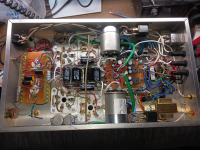I am wondering if anyone has tried matching these tubes, and if so are the results all over the place? I built a pair of monoblocks each using 4 tubes in PPP configuration loosely based on the Ciuffoli OTL v8.2 schematic. I have 12 tubes and am measuring the cathode current at 145v Anode and at -50 and -55v bias points. I have results at -50 ranging from 50ma to 245ma with clusters around 110 and 220ma. I am going to need probably 8 more to get 2 fairly matched quads. Surely for a military application they can't be this bad?
Attachments
Russian tubes are great, but if you want to have fairly matched pieces, you need atleast 20pcs 6C33C. I measured a lot of them on my tube tester RoeTest V10 and yes, they are not consistent.
Regards
Regards
They don't need to be consistent. They are intended as pass regulators in high voltage power supplies. In this application they run directly under active control (100% feedback) all the time. So long as they have sufficient control range it makes no difference how much unit to unit variability there is (within reason).Surely for a military application they can't be this bad?
Just more of the trials and tribulations of using pass regulators as audio amplifiers. I've designed them in the past, but I'll probably never design another one. Just a little finicky for my taste.
6S33S like other low mu pass tubes work best with cathode (auto) bias. Original 6AS7G data "prohibit" the use with fixed bias.
Large variation of plate current is just inherent characteristic of low mu triodes.
Large variation of plate current is just inherent characteristic of low mu triodes.
The reason that these tubes show varying characteristics is NOT because of bad quality manufacturing. The main reason is that as the 6C33C has very high transconductance the internal spacing between the electrodes is very small and therefore even a tiny difference in the spacing will have a big effect on parameters, especially on gm, for lower gm tubes the spacing is larger and therefore a similar difference in spacing has less effect.
We meaure every tube at a given anode voltage and current and match them for equal grid voltage.
In a OTL amp I would recommend to match for equal grid voltage within 2V to minimise distortion, you would probably need at least 20 tubes to get 4 that are OK
We meaure every tube at a given anode voltage and current and match them for equal grid voltage.
In a OTL amp I would recommend to match for equal grid voltage within 2V to minimise distortion, you would probably need at least 20 tubes to get 4 that are OK
Yep I ended up buying more (6) than I needed for that reason. Some websites are offering matched pairs. The PP amp built uses servo bias to give 100W out of a pair in PP. I have to agree they do need a few minutes or so if they have not been used for a while before measurement.
Last edited:
In the Eastern Block (Warsaw Treaty) the military equipments has dedicated spare parts stored in warehouses.Surely for a military application they can't be this bad?
These devices made such under such circumstances that are suitable even for military use, have appropriate quality control markings.
These QC markings in USSR is "O.T.K." (standard factory quality control) and -even- "ВП" (military factory quality control). See there.
The markings means that this device made under controlled conditions (OTK) and its tolerance even makes it suitable to use in military equipments too.
From these spare parts could be selected by measurement for a dedicated device. In this case the part received a designation, suitable for redeeming a given unit of a given asset (position number).
After the prescribed operating time expired, it was replaced by an -unskilled- soldier. From given position number tube pull out, marked spare tube plug in.
No measuring, no check features, it works or not.
So the -still available now- soviet/russian "military" tubes (from surplus stores) does not mean that they are the "same" (within specified tolerance), they only guarantee that they will work under "military" conditions.
Actually the data sheet does show quite a spread of mu. My amp does seem to work under civilian conditions.
I can set most of the tubes to the desired bias current by adjusting the G1 voltage, and it sounds OK. I just think it would be better if all the tubes were near the same place on the curve. Maybe we should start a 6C33 tube bank? "Will trade a 160 for a 200"
Our experience is that tubes that need different grid voltages for a given anode voltage and current also differ in transconductance and Rp but not that much in amplification factor mhu. Using 2 tubes with different specs in a push-pull amp usually give less surpression of 2nd order distortion.
For paralleling tubes in an OTL the tubes need to be very similar in needed grid voltage for a given current as otherwise either available output power will be lower or there will be a risk of current hogging risking the destruction of one of the tubes, current sharing resistors in each cathode is recommended, (also indicated on original 6C33C datasheet) .
For paralleling tubes in an OTL the tubes need to be very similar in needed grid voltage for a given current as otherwise either available output power will be lower or there will be a risk of current hogging risking the destruction of one of the tubes, current sharing resistors in each cathode is recommended, (also indicated on original 6C33C datasheet) .
- Home
- Amplifiers
- Tubes / Valves
- Matching 6C33C-B tubes
